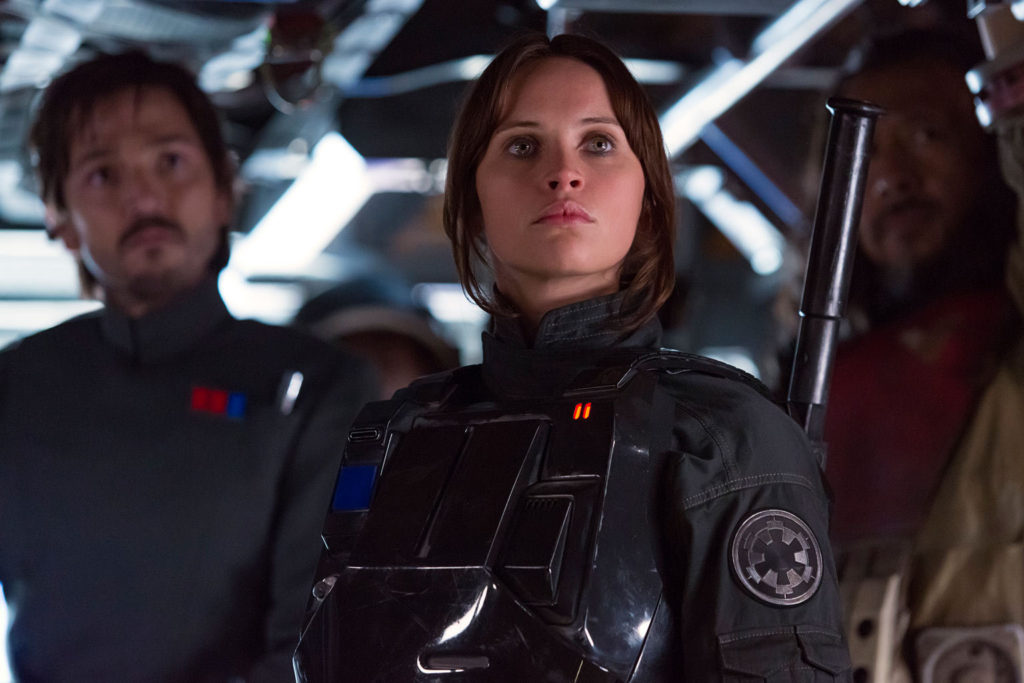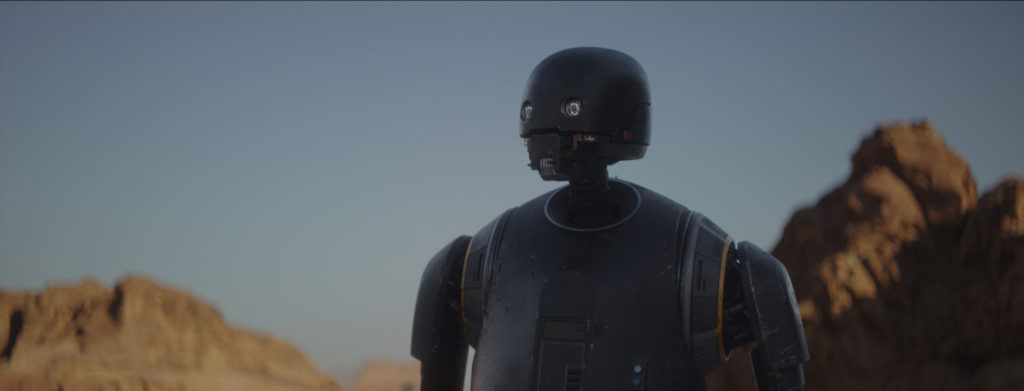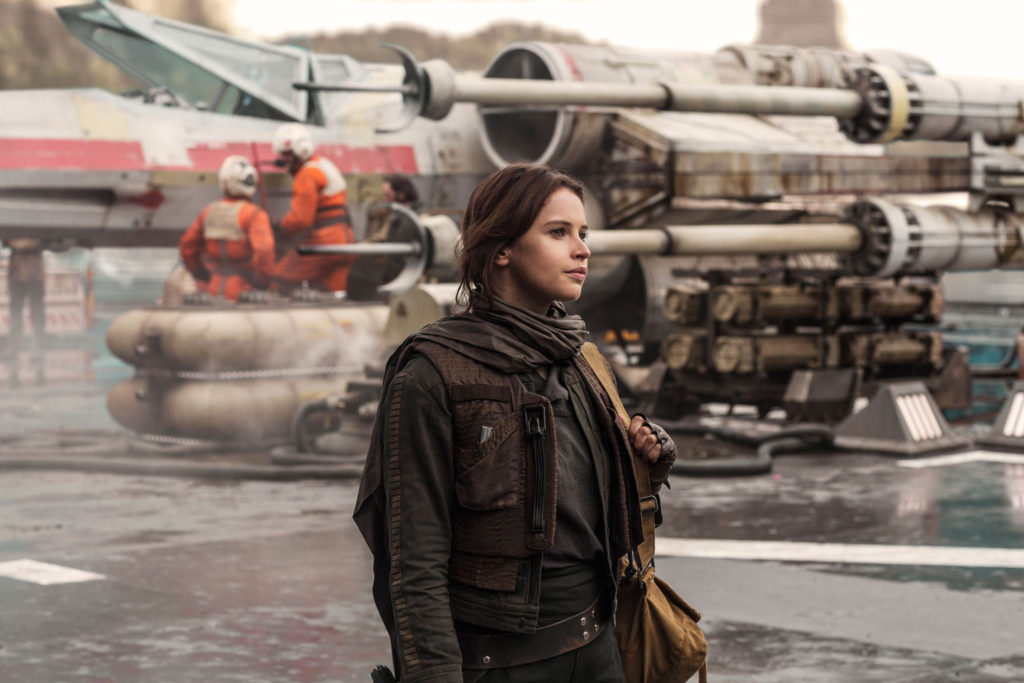
More than any film this year, I was crazy excited for Rogue One: A Star Wars Story. While I was initially skeptical of the anthology film concept when it was first announced, I’ve been on the Rogue One hype train since the first trailer dropped. It was a mesmerizing piece of advertising that promised a truly different type of Star Wars film, one that traded in the science fantasy elements of Jedi Knights and a strictly good-vs-evil plot for a more grounded and brutal war film. Everything we saw about the film suggested that this could be the darkest, most different film to come out of the storied franchise. Really, my biggest worry was that I was so hyped for Rogue One that it couldn’t possibly live up.
My fears were unfounded; not only did Rogue One blow away every expectation I had, it stands as quite possibly the richest, most complex film in the entire series. And while I’m always loathe to claim a film my favorite in a franchise immediately after seeing it, I can’t remember coming away from a movie with this much positive energy in quite a while.
If you’re somehow not in the know, Rogue One is set shortly before the events of the original Star Wars, following the story of the group of Rebels who would end up stealing the Death Star plans for the Alliance. More specifically, the film focuses on Jyn Erso (Felicity Jones), a young woman whose father Galen (Mads Mikkelson) has long been a captive of the Empire. Knowing that Galen is in charge of development of the Death Star, the Rebel Alliance breaks Jyn out of prison so they can use her connections to locate her father.
Jyn is paired with Rebel assassin Cassian Andor (Diego Luna) and reprogrammed Imperial droid K-2SO (Alan Tudyk). Along the way, the team is rounded out by Force believer Chirrut Îmwe (Donnie Yen), warrior Baze Malbus (Jiang Wen), and Imperial defector Bodhi Rook (Riz Ahmed), with the team frequently coming into conflict with Imperial Officer Orson Krennic (Ben Mendelsohn).

Rogue One introduces a large cast of characters, with the biggest focus going to the starting trio of Jyn, Cassian, and K-2SO. As far as crowd-pleasing favorites, K-2 is likely to be the standout, a sarcastic, blunt droid that’s different enough from past favorites like R2 and BB-8 while still being lovable in his own way. Cassian, meanwhile, has basically lived his entire life fighting the Empire, which has left him fairly haunted by the things he’s seen and done. More than any other character, Cassian helps emphasize the moral grey area that is often ignored in Star Wars films, bringing up the numerous assassinations and bombings committed by the Alliance in the name of defeating the Empire.
The star of the show, however, is Jyn Erso. Felicity Jones delivers a phenomenal performance that quickly propels Jyn to the top tier of Star Wars characters alongside Han Solo, Ahsoka Tano, and Darth Vader. Jyn is given the largest arc in the film, with her journey from a disillusioned, abandoned individual to a driven, hopeful member of the Rebel Alliance being an absolute joy to behold. We’re connected to Jyn’s story from the opening flashback to the bitter end, and she stands as one of the year’s best film characters.
The rest of the cast gets less to do, and the lack of real development for these characters is one of the film’s few faults. Baze, Chirrut, and Baze all get showcase heroic moments, but we never really learn too much about what makes them tick. More problematic, while Krennic strikes an imposing figure early on, his threat is frequently undercut but several other antagonists that basically amount to cameo appearances. More on that in a bit.
In many ways, the vague beats of the plot are familiar, but it’s the execution that allows Rogue One to stand out. As mentioned above, Rogue One is far more of a war film than any previous Star Wars movie. Instead of epic lightsaber duels and space station battles, the combat in Rogue One is far more grounded. Stealth missions are taken under the cover of rainfall, civilian populations are put in real danger, and the Stormtroopers take deadlier aim than ever before when fighting against regular Alliance forces.

The greater emphasis on those war elements leads to a far darker film than normal, but what gives Rogue One its heart is the sense of hope that runs throughout. One of the film’s most chilling and inspiring moments is Jyn’s speech to the Rebel Alliance’s leaders late in the film. She says that “rebellions are built on hope,” and while it’s a scene spoiled by the trailers, it still manages to hit hard in its proper context, delivered at that particular point in Jyn’s journey. That quote speaks to the film’s mission statement, and it’s what provides a glimmer of light even in the grimmest moments. Rogue One is somehow both the series’ darkest film and it’s most inspiring.
Truly, then, the film’s biggest flaws come from how closely tied it ends up being to A New Hope, the film that immediately follows it in the chronology. Given that this is the story of stealing the plans to the Death Star, that connectivity is to be expected and is, in many ways, additive. Appearances from Mon Mothma and Bail Organa help to give the proceedings a sense of narrative legitimacy, while the way the film wraps up makes for a fairly seamless flow into the events of the following movie.
However, sometimes those attempts to tie everything together trip up the narrative, and this leads to the single worst thing about Rogue One: the CGI abomination that is Grand Moff Tarkin. There’s no getting over how unsettling this recreated vision of Peter Cushing is, a new heir to the king in the uncanny valley. The animation is just a mite too obvious, and it’s unsettling to see this creation interact with the actual actors. It’d be one thing if Tarkin was just a brief appearance, but he pops up several times throughout.
This also plays to the film’s undercutting of Krennic, who becomes far less threatening as Tarkin – and eventually Vader – continue to make him look like a fool. The character’s personal relationship with Galen give him a necessary stake in the story, but he the movie tears him down when it should’ve been working to build him up.
Still, the skin-crawling visage of Tarkin is nowhere near a big enough misstep to detract from Rogue One’s many high points. By deviating from so much of what has traditionally defined Star Wars, director Gareth Edwards is able to deliver one of the series’ greatest, most unique installments. If this is indicative of the quality we can expect from future anthology films, I may be more excited to see those movies than what happens next in the main saga.
Final Score: 9 out of 10